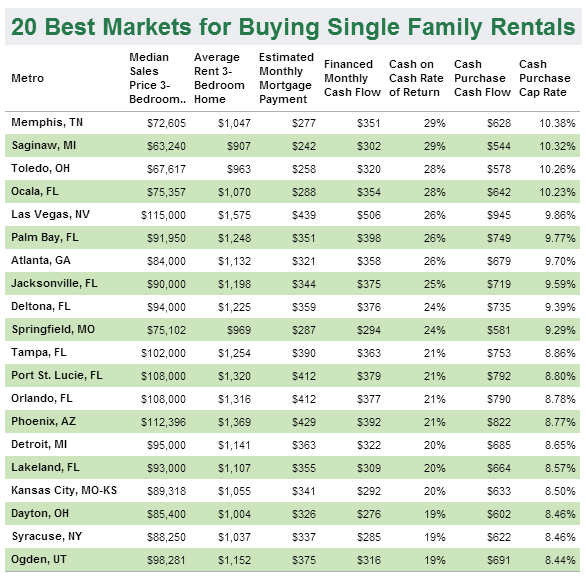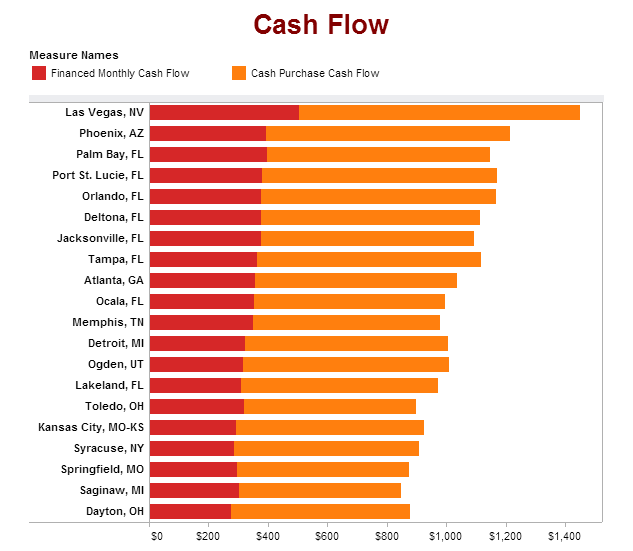While buying single family rental properties has become the darling investment strategy of Wall Street, it may not always make sense for individual real estate investors — particularly in some markets already picked over by the large institutional investors. But there are still markets where the numbers work for the conservative, individual investor looking to purchase foreclosures and other homes as single family rentals.
RealtyTrac developed a list of the 20 best markets nationwide for purchasing single family rentals by analyzing median sales prices and average rental rates for 3-bedroom homes and using that data to calculate capitalization “cap” rates and average cash flows.

Shifting with the market
Good opportunities for single family rentals are available in nearly every market across the country, it just may be harder to find them in higher-priced markets like Orange County, Calif., where real estate investor Lin He is based.
“I bought a number of rentals in OC a couple of years back, but now I am getting some smoking deals in Los Angeles and the Inland Empire (Riverside and San Bernardino counties in Southern California),” he wrote in an email. “I just picked up a triplex and a single house on one lot in LA for $217k. Its gross rent is close to $6,000. That’s a heck better than 1 percent rule (see explanation of this rule in methodology below).”
Calculating cash flow and cap rates
Cash flow is simply the difference between the income produced by the property in the form of monthly rent and the costs associated with the property: mortgage payment, property taxes, insurance, repairs, etc. Positive cash flow is always the goal, and negative cash flow is best avoided. The cap rate is the percentage that the net annual income produced by the property (monthly cash flow multiplied by 12) represents of the original purchase price paid for the property.
For example a home purchased for $100,000 that generates $500 in positive net cash flow each month would have a 6 percent cap rate ($500 multiplied by 12 is $6000, which is then divided into the original $100,000 purchase price).
To calculate cap rate and cash flow, we assumed a 20 percent down payment and a 4 percent interest rate to come up with an estimated monthly mortgage payment. Based on feedback from real estate investors we subtracted an additional 40 percent out of the gross monthly rental proceeds for property taxes, insurance and repairs.

More on methodology
We limited the list to metro areas with a population of at least 200,000 where the necessary price and rental data was available and then further restricted the list to markets where the average monthly gross rent of a 3-bedroom home was at least 1 percent or more of the median sales price in that market (using an old rule of thumb that many veteran real estate investors simply refer to as “the 1 percent rule”). We then sorted the list by the cap rate, highest to lowest and selected the top 20 on the list.
Property particulars important
While the 1 percent rule and the 40 percent rule mentioned above are useful to provide “general overall initial calculations,” veteran real estate investor Tony Alvarez cautioned that the particular characteristics of each property purchased must be taken into account to determine the true return on investment.
“You must address specifics of the properties being analyzed or compared such as, are the properties we are considering only single family residence, what is the age, quality of construction, level of past maintenance, physical location within a given neighborhood, will the owner be paying any portion of the utilities such as water, electric, gas, trash or Home Owner’s Association dues,” he wrote in an email.
Alvarez noted that in the more than 30 years he has been investing, he has owned and rented hundreds of units ranging from small single family residences to higher-end oceanfront condos in Santa Monica and large apartment buildings and commercial shopping centers.
“The bottom line is, the best rental property for an individual to buy is the one he or she both understands best and is able to manage most efficiently and effectively,” he said. “The rest is basically just conversation.”

